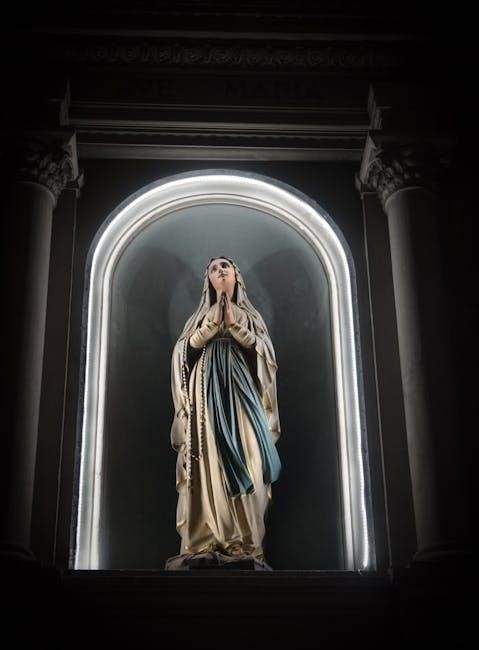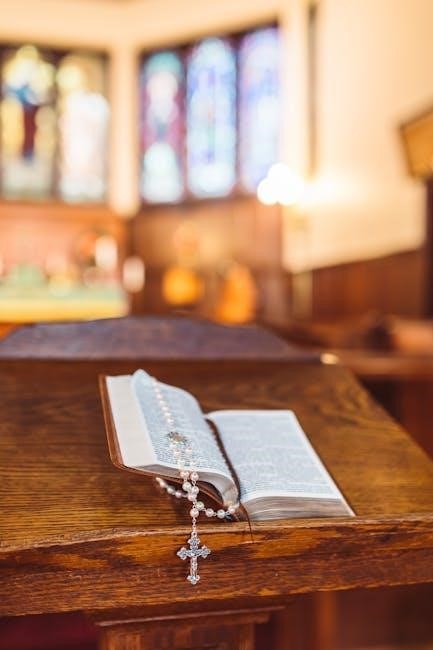What is the Rosary?
The Rosary is a traditional Catholic devotion. It is centered on prayer and meditation, using beads to count repetitions. It involves reciting specific prayers while meditating on the Mysteries of the Rosary.
What is the Rosary?
The Rosary is a powerful and ancient prayer tradition in the Catholic Church. It is a Scripture-based prayer, centered around meditating on key events in the lives of Jesus Christ and his mother, Mary. The Rosary involves reciting specific prayers in a set sequence, using Rosary beads to keep track. These prayers include the Apostles’ Creed, the Our Father, the Hail Mary, and the Glory Be. The Rosary is structured around “decades,” each consisting of one Our Father, ten Hail Marys, and one Glory Be. Before each decade, a particular Mystery is announced, focusing meditation on a specific event from the life of Jesus or Mary. By contemplating these Mysteries, we draw closer to Christ and grow in faith, hope, and charity. It is concluded by the Hail Holy Queen and the Sign of the Cross.

How to Pray the Rosary
Praying the Rosary involves a series of prayers and meditations. Starting with the Sign of the Cross, followed by the Apostles’ Creed, it proceeds with Our Father, Hail Mary, and Glory Be prayers.
Sign of the Cross
The Sign of the Cross is a fundamental prayer and gesture. It marks the beginning and end of the Rosary. It is a profession of faith in the Holy Trinity. It is made by touching the forehead, chest, left shoulder, and right shoulder. While making the gesture, recite the words: “In the Name of the Father, and of the Son, and of the Holy Spirit. Amen.”
This act invokes divine protection and blessing. It acknowledges the Father as Creator, the Son as Redeemer, and the Holy Spirit as Sanctifier. It is a powerful symbol of Christian belief and a prayer in itself. The Sign of the Cross is a reminder of Christ’s sacrifice and our commitment to follow Him. It is a universal practice among Christians.
The Apostles’ Creed
The Apostles’ Creed is a concise summary of Christian beliefs. It is recited after the Sign of the Cross. It affirms belief in God, the Father Almighty, Creator of heaven and earth. It then focuses on Jesus Christ, God’s only Son, our Lord. The Creed details Jesus’s conception, birth, suffering, death, and resurrection. It includes His ascension into heaven and His future return to judge the living and the dead.
Furthermore, the Creed professes belief in the Holy Spirit, the holy Catholic Church, the communion of saints, the forgiveness of sins, the resurrection of the body, and life everlasting. Reciting the Apostles’ Creed solidifies one’s faith and connects them to the universal Church. It is a powerful statement of core Christian doctrines, setting the foundation for prayer and meditation.
Our Father
The “Our Father,” also known as the Lord’s Prayer, is a central prayer in Christianity. Jesus Christ taught this prayer to His disciples, emphasizing its importance. We begin by acknowledging God as “Our Father, Who art in heaven,” recognizing His holiness. “Hallowed be Thy Name” expresses reverence for God’s sacred name.
“Thy Kingdom come, Thy Will be done, on earth as it is in heaven” implores God’s reign and purpose to be fulfilled. We ask for our daily needs with “Give us this day our daily bread.” “And forgive us our trespasses, as we forgive those who trespass against us” seeks forgiveness and promotes reconciliation. The prayer concludes with “And lead us not into temptation, but deliver us from evil,” asking for protection from harm. “Amen” affirms our faith in God’s answer to the prayer.
Hail Mary
The “Hail Mary” is a prayer of praise and petition to the Virgin Mary, mother of Jesus. We begin by saying “Hail Mary, full of grace, the Lord is with thee,” acknowledging Mary’s unique blessedness. “Blessed art thou amongst women, and blessed is the fruit of thy womb, Jesus,” praises Mary and her son, Jesus Christ.
We then turn to supplication, saying, “Holy Mary, Mother of God, pray for us sinners, now and at the hour of our death.” This plea seeks Mary’s intercession with God on our behalf. We ask for her prayers during our present lives and at the critical moment of our passing. The prayer acknowledges our sinfulness and our need for divine mercy. The “Hail Mary” is repeated many times during the Rosary, emphasizing Mary’s role in salvation history. It is a powerful prayer for guidance and protection.
Glory Be
The “Glory Be” is a short doxology, a prayer of praise to the Holy Trinity. It affirms the unity and equality of the Father, the Son, and the Holy Spirit. The prayer begins with “Glory be to the Father, and to the Son, and to the Holy Spirit,” acknowledging the divine persons. It continues with “As it was in the beginning, is now, and ever shall be, world without end. Amen.”
This phrase emphasizes the eternal nature of God. God existed before creation, exists now, and will exist forever. The “Amen” affirms our belief in the truth of the prayer. The “Glory Be” is a constant reminder of God’s greatness and our dependence on Him. It is recited after each decade of the Rosary, offering praise and thanksgiving. This prayer provides a moment of reflection on the divine mystery. It helps us to deepen our relationship with God and to recognize His presence in our lives.

The Mysteries of the Rosary
The Rosary’s mysteries consist of meditations on events in the lives of Jesus and Mary. There are twenty mysteries, divided into four sets: Joyful, Luminous, Sorrowful, and Glorious, each offering unique reflections.
Joyful Mysteries
The Joyful Mysteries are traditionally recited on Mondays and Saturdays. They focus on the early life of Jesus and Mary, offering reflections on events filled with joy and anticipation. These mysteries invite us to contemplate the Incarnation and the beginnings of our salvation.
The first Joyful Mystery is the Annunciation, where the Angel Gabriel announces to Mary that she will conceive and bear the Son of God. The second is the Visitation, where Mary visits her cousin Elizabeth, who is also pregnant. The third is the Nativity, the birth of Jesus in Bethlehem. The fourth is the Presentation of Jesus in the Temple. Finally, the fifth is the Finding of Jesus in the Temple, where he is found teaching among the elders.
Meditating on these mysteries allows us to share in the joy and wonder surrounding these pivotal moments in Christian history.

Sorrowful Mysteries
The Sorrowful Mysteries, traditionally prayed on Tuesdays and Fridays, invite us to contemplate the suffering and sacrifice of Jesus Christ. These mysteries focus on the events leading up to Jesus’ crucifixion, offering a profound reflection on his love and obedience to the Father.
The first Sorrowful Mystery is the Agony in the Garden, where Jesus prays in anguish before his arrest. The second is the Scourging at the Pillar, where Jesus is brutally whipped. The third is the Crowning with Thorns, where Jesus is mocked and crowned with thorns. The fourth is the Carrying of the Cross, where Jesus bears the weight of the cross to Calvary. Finally, the fifth is the Crucifixion, where Jesus is crucified and dies on the cross.
Through meditating on these mysteries, we can grow in our understanding of the depth of Christ’s sacrifice.
Glorious Mysteries
The Glorious Mysteries, traditionally prayed on Wednesdays and Sundays, focus on the triumph of Jesus Christ and the Blessed Virgin Mary. These mysteries celebrate the resurrection and ascension of Jesus, as well as Mary’s assumption into heaven and coronation as Queen of Heaven and Earth.
The first Glorious Mystery is the Resurrection of Jesus, where Jesus rises from the dead, conquering sin and death. The second is the Ascension of Jesus, where Jesus ascends to heaven to sit at the right hand of the Father. The third is the Descent of the Holy Spirit, where the Holy Spirit descends upon the apostles and Mary in the Upper Room. The fourth is the Assumption of Mary, where Mary is taken body and soul into heaven. The fifth is the Coronation of Mary, where Mary is crowned Queen of Heaven and Earth.
These mysteries offer hope and remind us.
Luminous Mysteries (Mysteries of Light)
The Luminous Mysteries, also known as the Mysteries of Light, are a set of meditations on the public life of Jesus Christ. These mysteries, introduced by Pope John Paul II in 2002, bridge the gap between Jesus’ childhood and his Passion. They are traditionally prayed on Thursdays.
The first Luminous Mystery is the Baptism of Jesus in the Jordan, where Jesus is baptized by John the Baptist. The second is the Wedding Feast at Cana, where Jesus performs his first miracle. The third is the Proclamation of the Kingdom of God, where Jesus calls all to conversion. The fourth is the Transfiguration, where Jesus is transfigured before Peter, James, and John. The fifth is the Institution of the Eucharist, where Jesus institutes the Eucharist at the Last Supper.
These mysteries highlight Jesus’ ministry and divine nature.

Concluding the Rosary
After meditating on the mysteries, the Rosary is traditionally concluded with specific prayers. These prayers offer praise and petition to the Blessed Virgin Mary. They ask for her intercession and guidance.
Hail Holy Queen
The Hail Holy Queen is a traditional Marian prayer often recited at the conclusion of the Rosary. It serves as a final act of devotion and supplication to the Blessed Virgin Mary. This prayer seeks her intercession and guidance as a merciful advocate for those on Earth. The words of the Hail Holy Queen express trust in Mary’s powerful role as a mother and queen, turning to her for solace and protection. It acknowledges her as a source of hope and comfort in times of trouble, appealing to her maternal heart for assistance. The prayer highlights Mary’s virtues, emphasizing her mercy, kindness, and love. Through this fervent plea, those who pray seek her help in navigating life’s challenges. It is a beautiful way to end the Rosary.
